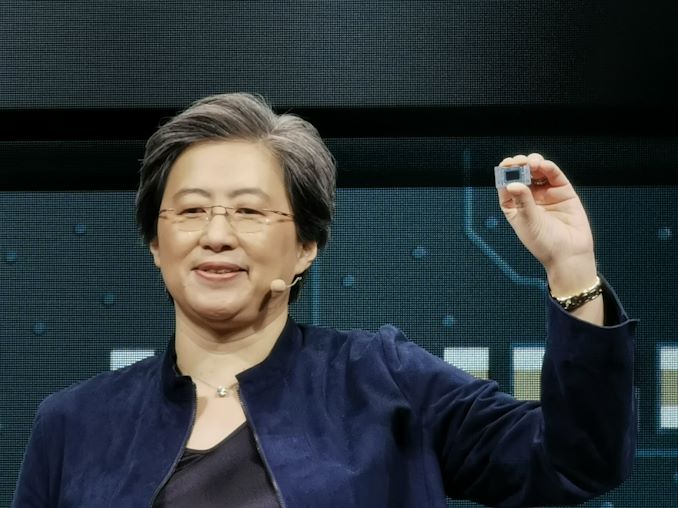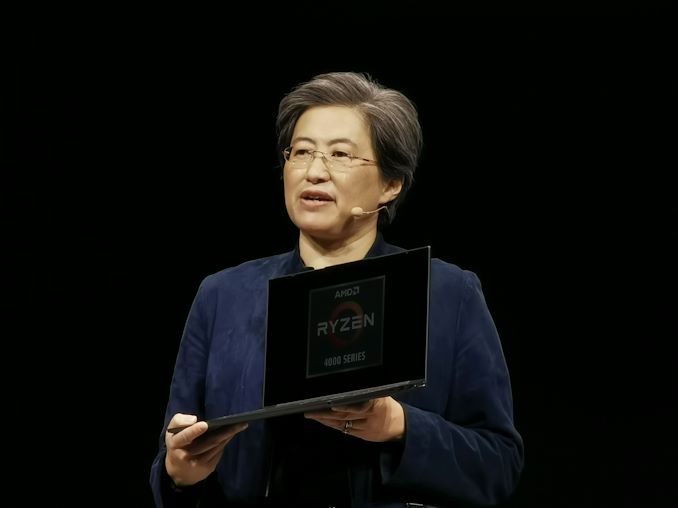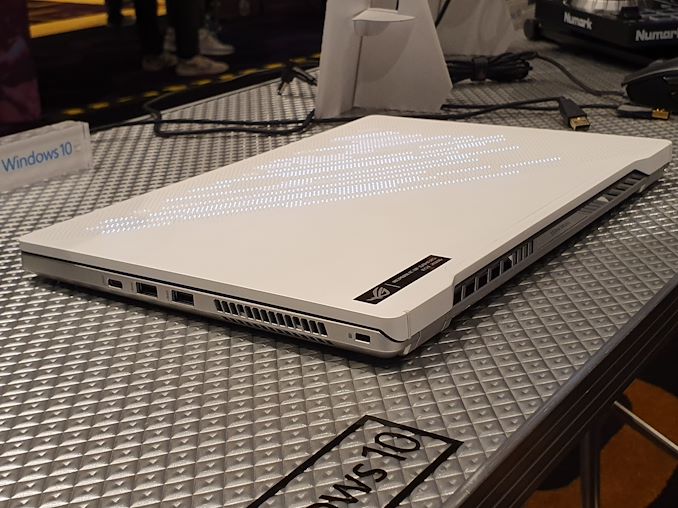AMD Details Renoir: The Ryzen Mobile 4000 Series 7nm APU Uncovered
by Dr. Ian Cutress on March 16, 2020 11:00 AM ESTThe Special HS Processors
As mentioned, at the top end of the new Ryzen Mobile 4000 list are the HS processors, offering almost exactly the same specification as the 45 W H-series processors, but at 35 W. AMD has marked these as special processors, not available to every OEM, because they fall under AMD’s new cooperative design and continuous validation programs.
In order to be able to use a HS processor, an OEM must work with AMD on the design. This is similar to what Intel does – ensure that the OEM partner gets the best from the hardware, and try and assist as to what design decisions the hardware was built for. Ultimately the product that comes out should be one that shows off the best of the hardware and gives the best user experience. On top of this, AMD has a list of ‘assured components’, validated to work against the new processors, and has created two continuous validation labs.
These labs, one in Austin and one in Shanghai, take the systems and pre-test all the new drivers and vendor software on them before they are released to the public. This is to ensure that the system is in no way compromised in performance, power, or thermals as a result of the update (to ensure that a company doesn’t completely mess with the power profile after it launches through a BIOS update or similar). AMD didn’t state how long its continuous validation program will run after the product is shipped, though I should think that at least 12-18 months should be plausible.
If the OEM does all this, and AMD agrees, then the product can use one of the HS processors.
(Note, the normal 45 W processors can be run in a 35 W mode, but just doing that doesn’t mean you can call it a HS. No doubt some third-tier OEM might try…)
The first HS-class system on the market will be the ASUS Zephyrus G14, and we learned in January that ASUS’s design has an exclusive for six months from launch. We’re expecting the G14 to hit the market in Q2, even with the current state of production, so we’ll see more HS models later in the year.
Conclusions
Ultimately today was the day that AMD was going to lift the embargo on Ryzen Mobile 4000 reviews, with the systems that AMD and its partners have provided. Due to the current ongoing issues around the world, those technical reviews of the systems will have to wait a few weeks while production is being ironed out. But for now we have a good grasp as to what AMD has pushing into the new processors coming out later this year.
Regular readers of AnandTech may remember back in 2016 I wrote a very long piece about AMD’s laptop strategy, where I tested five laptops from OEMs that were using AMD’s latest Carrizo APU at the time. The conclusions to that review were three fold: AMD was shooting itself in the foot by providing a platform that allowed its partners to be cheap; the OEM partners were being cheap by giving the hardware 13x7 screens, poor storage, poor trackpads and such because that’s all the customers seemed to want; and the customers were continually asking for cheaper systems, then getting frustrated with the poor user experience, ultimately blaming AMD rather than the OEM. It was a vicious cycle that required someone to break it.
Normally for these launches, a company will create a reference design for its partners to work with. AMD for years was creating these dull $500-$700 reference designs, which ultimately led to the paragraph above. We pled for generations for AMD to make a halo reference design, something ultraportable for $1500. For Renoir, given the reasonable performance uplift from the previous generation, the company worked with partners to create a range of high profile devices. I’ve covered a few of them in this article – the Lenovo Yoga Slim 7, the Dell G15 SE, and the ASUS Zephyrus G14 all attack different markets in very different ways, but all are examples of high-end products and design wins that AMD has needed in this market.
One of AMD’s big targets here is commercial. Despite the poor consumer performance of its older generations of laptops, the commercial laptop arm of AMD did reasonably well by comparison. AMD has announced its Ryzen Mobile 4000 Pro designs that afford admin control and sustainability over the lifetime of the product, and the key win here is that we’re seeing the processors in Lenovo’s Thinkpads, a key market.
The other big market is gaming. AMD can attack this on two fronts - the ultraportable market with the improved integrated graphics should get some good perfomrance, but also the more power hungry gaming market will get access to features like SmartShift to help balance the power between the APU and discrete GPU. AMD is also playing in the middle market here, with devices like the ASUS Zephyrus G14 with a HS processor and a Radeon RX5600M inside a 14-inch chassis, which AMD claims is the first 14-inch device with a H-class CPU and a discrete GPU inside. AMD's gaming team seem to be very happy with this design.
However, announcing systems is one thing. Deploying them is another. AMD has made a lot of claims about its Ryzen Mobile 4000 platform – performance, power consumption, and battery life. We’ve gone into detail into a lot of these, but we’re still missing one piece of the puzzle – the on-hand data. We’re hoping to get a system or two here in due course, and compare it against the competition.














95 Comments
View All Comments
R3MF - Monday, March 16, 2020 - link
Tell me about [desktop] Renoir...?Ian Cutress - Monday, March 16, 2020 - link
Not yet. As far as I know, AMD is focusing on mobile first, so you'll have to come back later in the year. I suspect they'll time the launch of B550 around the same time.R3MF - Monday, March 16, 2020 - link
thank you (including for the article - which is a great read).thinking about the possibility of desktop Renoir, its interesting that:
a) on the media engine side - there is no sign of AV1
b) on the display output side - there is no mention at all (inc hdmi 2.1)
it seems to me that AMD would have a real opportunity to grab the HTPC market if it achieved both of the above.
do you think there is any chance that
1. the lack of AV1 is a function of speed, i.e. a 65W Renoir media engine might have the grunt to do it?
2. the absence of information on the display output side is deliberate, i.e. AMD is holding this back for desktop?
Moizy - Monday, March 16, 2020 - link
Media encoding/decoding capabilities are certainly important, but it seems like the "HTPC market" has dwindled into a really, really small niche, too small to influence design decisions in and of itself. But that's just my perspective, don't have actual data. It's just so cumbersome compared to streaming.DanNeely - Monday, March 16, 2020 - link
Yeah. HTPC is dead as far as driving features; streaming (games, etc) and video editing are the drivers for encoding support on the PC these days.a5cent - Monday, March 16, 2020 - link
Seems like everything I care about is niche :-/HTPC barely a blip on the radar and finally, after years of waiting, maybe, MxGPU support, or something GVT-g compatible. Make it happen AMD. Report on it Anandtech!
close - Tuesday, March 17, 2020 - link
Well HTPC is an unfortunate combination of things that can be delivered in many other ways now that technologies are shifting (mostly to mobile and streaming). Most people no longer want a (relatively) bulky and expensive full PC in their media lineup. They might have a NAS that can do it all (storage for the whole network, streaming, transcoding, output directly to TV, etc.) at a fraction of the cost, size, and effort to build and maintain. Between this and a smart TV the role of the HTPC is purely to make some enthusiasts happy.WaltC - Tuesday, March 17, 2020 - link
I love my "expensive" PC, thank you...;) I would not trade it for a device, ever.Threska - Tuesday, March 17, 2020 - link
HTPC might, but the NAS market is still there, and that's where the functionality has folded. This APU would fit right in and be an improvement of the usual anemic CPUs used in such machines.Namisecond - Thursday, March 26, 2020 - link
A NAS based on one of these APUs would also be in the price range of "enthusiast" or entry-level "enterprise" appliances. To the point that it might be more cost-effective to roll your own, especially to people who are picky enough to request this level of power and functionality from their NAS devices.